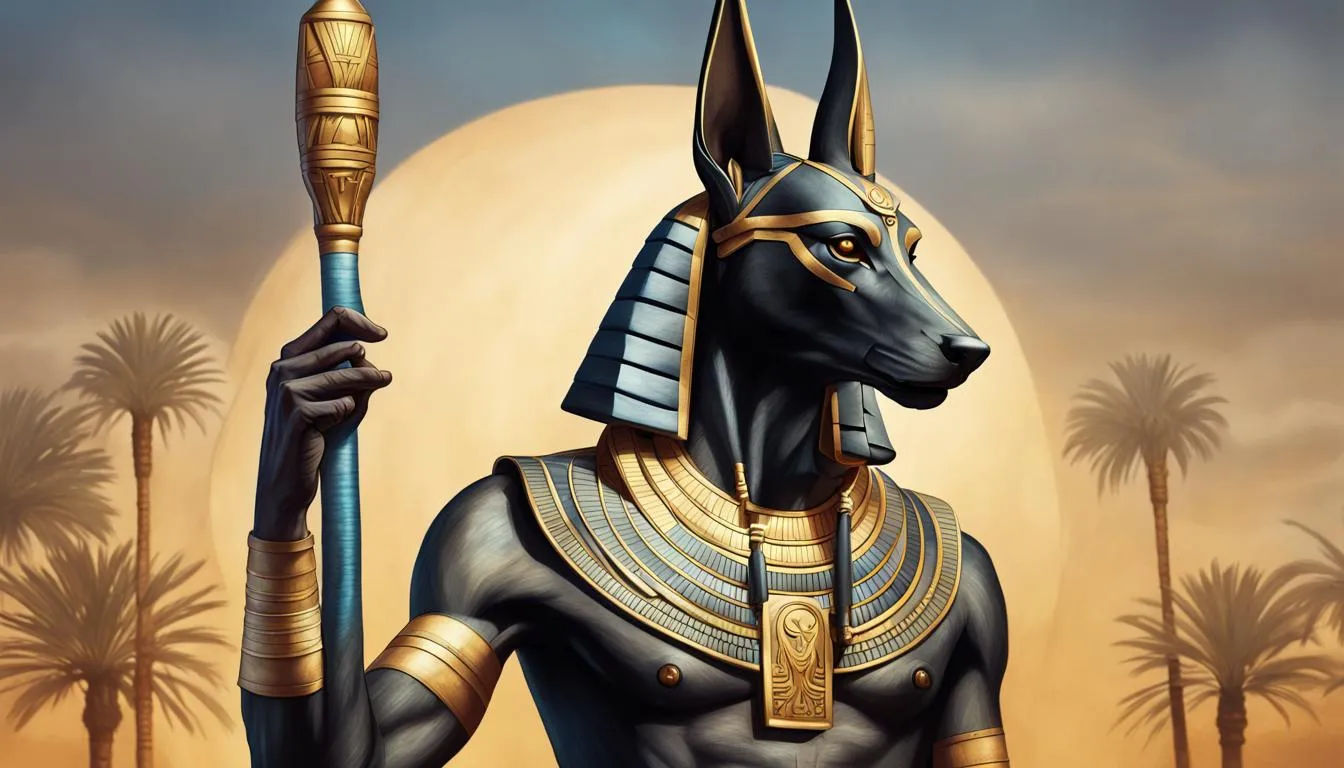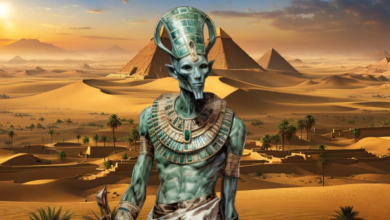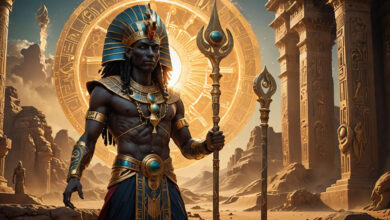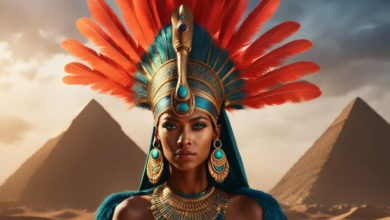Anubis, the jackal-headed god of the afterlife, embalming, and funerary rites, is one of the most iconic and fascinating figures in ancient Egyptian mythology. His image, often evoking a sense of mystery and solemnity, has permeated the ancient world and modern culture, symbolizing the ancient Egyptians’ complex beliefs about death, the afterlife, and the supernatural. This article delves into Anubis’s origins, roles, myths, and lasting legacy, offering a glimpse into the ancient civilization that revered him and the enduring fascination he inspires.
The origins of Anubis are somewhat murky, with early mentions dating back to the Old Kingdom (c. 2686 – 2181 BCE). He is often described as the son of Osiris, the god of the afterlife and resurrection, and Nephthys, a goddess associated with the dead and mourning. However, in some myths, his parentage is attributed to Set, the god of chaos, storms, the desert, and Nephthys. Despite these variations, Anubis’s role as a protector and guide of the dead is a constant, underscoring his importance in the Egyptian pantheon.
Anubis’s depiction as a jackal or a man with the head of a jackal is deeply symbolic, reflecting the Egyptians’ observations of jackals stalking the edges of the desert near the cemeteries where the dead were buried. This imagery links Anubis to the desert as the liminal space between life and death and the jackal’s role as a scavenger to Anubis’s function as a protector of graves and a guardian against desecration. His black fur, unusual for a jackal but symbolic of the fertile, life-giving soil of the Nile, represents rebirth and regeneration, further emphasizing his connection to the afterlife.
Anubis’s primary role in Egyptian mythology was as the god of mummification. He was believed to have embalmed Osiris, thus setting the precedent for the mummification of the dead. This process was vital for the Egyptians, who believed that preserving the body was essential for the soul’s survival in the afterlife. Anubis’s expertise in embalming and his role in the mummification rituals underscored his importance in ensuring the dead’s safe passage to the afterlife.
Beyond his association with mummification, Anubis also kept poisons and medicines, reflecting the dual nature of healing and harm. His knowledge of the secrets of the physical body made him an influential figure in both life and death, embodying the thin line between the two states.
One of Anubis’s most significant roles was as the psychopomp, the guide of souls to the afterlife. In this capacity, he oversaw the Weighing of the Heart ceremony, a critical step in the journey of the dead. According to the Book of the Dead, the deceased’s heart was weighed against the feather of Maat, the goddess of truth and justice. With his scales of justice, Anubis would determine whether the soul was worthy of entering the Field of Reeds, the Egyptian paradise. This role as judge and guardian of the scales emphasized Anubis’s connection to truth, morality, and the ultimate fate of the soul.
Anubis’s myths often highlight his benevolence and dedication to the dead. Unlike many deities of the ancient world, Anubis was not feared but respected and loved, seen as a protector who ensured the safety and well-being of the deceased in their journey to the afterlife. His compassion and guidance comforted the living, who trusted in his ability to care for their loved ones after death.
The worship of Anubis was widespread throughout Egypt, with numerous temples and shrines dedicated to him. The cult of Anubis continued to flourish even as Osiris’s popularity as a god of the afterlife increased. Over time, the roles of Anubis and Osiris began to overlap, with Anubis becoming more closely associated with the embalming process and the care of the dead, while Osiris took on the role of the ruler of the afterlife. This transition did not diminish Anubis’s importance but solidified his position as an essential intermediary between the living and the dead.
Anubis’s legacy extends far beyond ancient Egypt. His distinctive image has captured the imagination of people across centuries, making him a subject of fascination in art, literature, and popular culture. From Renaissance paintings to modern films and video games, Anubis’s portrayal as the jackal-headed god of the dead evokes a sense of mystery and reverence. His enduring appeal lies in his complex nature, embodying the ancient Egyptians’ sophisticated understanding of death and the afterlife.
In contemporary times, various spiritual and esoteric traditions have embraced Anubis’s symbolism, reflecting his multifaceted role as a guardian of the dead, a judge of souls, and a master of mysteries. His figure is often invoked in discussions about the transition from life to death, serving as a reminder of the ancient belief in a dignified passage and a balanced judgment in the afterlife. Anubis’s presence in these traditions underscores his timeless relevance, embodying themes of protection, justice, and the eternal cycle of life and death.
Moreover, Anubis’s role in the embalming process and the Weighing of the Heart ceremony highlights the ancient Egyptians’ deep concerns with ethics, morality, and the afterlife. These practices reflect a culture that values righteousness, truth, and harmony in life and beyond. In overseeing these rituals, Anubis served as the embodiment of these values, guiding the dead through the trials of the afterlife and ensuring that only the worthy could enter the Field of Reeds.
The mythology surrounding Anubis also offers insights into the ancient Egyptians’ perceptions of animals and their environment. The jackal, a creature that inhabited the deserts around the Nile and was often seen near cemeteries, was both feared and respected. In adopting the jackal as Anubis’s sacred animal, the Egyptians acknowledged the creature’s role in the natural world while imbuing it with divine significance. This synthesis of natural observation and religious belief is a testament to the ancient Egyptians’ deep connection to their environment and their ability to find spirituality in the world around them.
Anubis’s depiction in art and iconography, from temple reliefs to funerary artefacts, further attests to his significance in ancient Egyptian culture. These images, crafted with reverence and skill, were not merely decorative but served as vital components of religious practice, intended to invoke the god’s presence and protection. Through these artistic representations, Anubis continues to watch over the dead, and his image is a powerful symbol of the ancient Egyptians’ spiritual aspirations and quest for immortality.
The fascination with Anubis in modern times speaks to the enduring power of ancient mythology to inspire, intrigue, and enlighten. As a figure who transcends the boundaries between life and death, Anubis challenges us to confront our mortality and to consider the legacy we leave behind. His myths, rich with symbolism and meaning, encourage us to reflect on our beliefs about the afterlife, justice, and the moral choices that define us.
In conclusion, Anubis is a testament to the complexity and depth of ancient Egyptian religion and mythology. His role as a guardian of the dead, a judge of souls, and a guide to the afterlife embodies the Egyptians’ sophisticated beliefs about death, morality, and the possibility of life beyond death. Through his enduring legacy, Anubis continues to captivate the imagination and enrich our understanding of one of the world’s most remarkable ancient civilizations. As we delve into his myths and explore his significance, we are reminded of the timeless human quest for understanding, justice, and the soul’s eternal journey.





